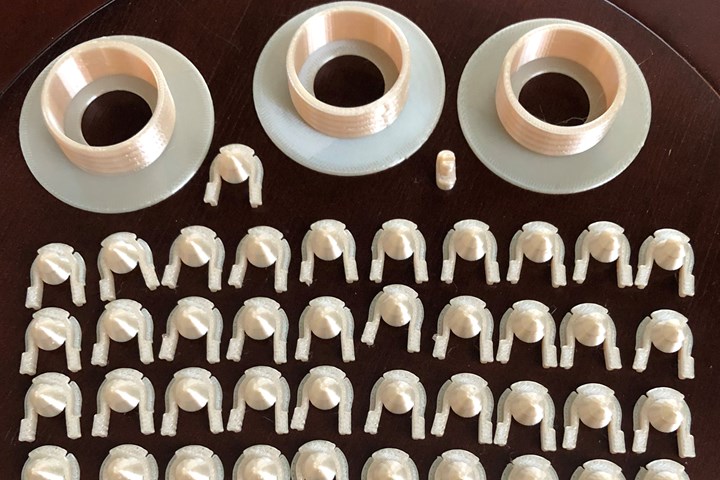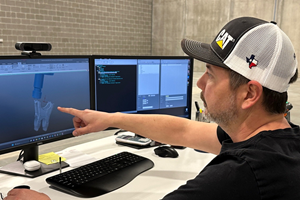Additive Manufacturing to the Rescue — Again
AM is the perfect candidate to solve production problems that began during the pandemic.
Share







Hwacheon Machinery America, Inc.
Featured Content
View More
Autodesk, Inc.
Featured Content
View More



ECi Software Solutions, Inc.
Featured Content
View MoreWhen supply chain issues first emerged, 3D printing helped ensure replacement parts were readily available for powdered air purifying respirators (PAPRs) during the early stages of the pandemic. Image: Timothy Simpson
When 3D printing first hit the market, not only was it a cool, “space-age” technology but it also solved a problem designers and engineers were having conveying their ideas and conceptual designs to others, what I have previously called the “prototyping problem.” Even better, 3D printing enabled rapid prototyping, which was not only faster, but also saved cost and added value to product development processes. Companies that used 3D printing were more innovative, or at least were seen as more innovative, and 3D printing companies — and the technology — flourished. 3D printing effectively solved the “prototyping problem,” and companies moved on to other challenges; market pull became technology push.
Examining the recent resurgence of interest in 3D printing, sometimes called additive manufacturing (AM) for its ability to produce end-use parts layer-by-layer thanks to advances in the technology (for example, laser powder bed fusion), it isn’t just because we can now 3D print metal parts. Granted, 3D metal printing was largely the “trigger” that launched the most recent hype cycle and caused the renaming, but companies once again faced a real problem that AM could solve. The problem was caused by the pandemic, and we continue to feel its effects even now.
When COVID hit, the inability to source personal protective equipment (PPE), including face shields, face masks and respirators, quickly became a healthcare crisis. For the first time in recent memory, placing an order did not guarantee that the order would arrive. We got so accustomed to one-click shopping and one-day shipping that it took everyone awhile to realize something was wrong. Worse, factories around the world shut down as countries went into lockdown and people went into quarantine. All of a sudden, manufacturing had a real problem. PPE could not be reliably produced or sourced anywhere in the world. Companies couldn’t get parts, and production faltered.
Production problems like this hadn’t plagued companies for decades, perhaps even a century if you go back to the days of Henry Ford and his all-encompassing River Rogue plant. Production had a problem: production couldn’t produce. Moreover, supply chains couldn’t deliver, and manufacturers felt a “double-whammy” unlike anything they had ever seen.
Like many other 3D printing fanatics and “makers” around the world, we formed our AM “rapid response” team, embarked on the race for PPE and ramped up for a fight to help protect the lives of others. With the help of 3D printing, we designed, prototyped, tested and deployed over 20 solutions to our healthcare workers over 100 days, in collaboration with GMP-compliant partners that ensured safety and compliance with FDA requirements.
Two years later, the pandemic persists thanks to the latest variants, but so do the supply-chain issues. In fact, they have gotten worse, not better. The ripple effect of factory closings, redirected orders and sold-off inventories has led to shortages in electronics and especially computer chips, which have delayed automotive sales and driven up prices of used cars, for example. Inflation is on the rise, and we complain about empty grocery shelves or long delays at restaurants due to staffing shortages, but that is nothing compared to what the healthcare workers have been facing — can we give each of them a Bronze Star for their service these past two years? Please be sure to thank every medical professional the next time you see one!
While 3D printing still falls short in producing electronics and computer chips, the success of AM in helping solve “the PPE problem” is giving people confidence that it can help solve other production problems. The big one right now is spare parts — what the aerospace industry refers to as maintenance, repair and operations (MRO) and the defense industry calls sustainment.
It shouldn’t come as a surprise that aerospace, automotive and defense companies can’t get the spare parts they need. Manufacturers are still rebuilding capacity to satisfy orders for new parts; few have idle machines available to make spares. Plus, spare parts are plagued by uncertain demand, low volume and high variety, necessitating large inventories in warehouses and distribution centers, which is expensive.
Wait a minute — low-volume, high-variety orders that need to be made on demand at any time? Sounds like a job for AM! In fact, the “spare parts problem” is even better suited for AM because many of the replacement parts are plastic and metal, which makes it simpler in many ways than the “PPE problem” that it helped solved two years ago.
Don’t get me wrong: safety, quality, regulatory compliance and the like are still essential; we just aren’t as worried about trapping a virus that is 0.3 micron or less in size when we are 3D printing replacement parts for cars or airplanes, as opposed to filtration cartridges for N95 masks. Car parts and airplane parts can’t fail either, but given the past three decades of R&D investment into AM, I think 3D printing is once again primed and ready to solve the latest manufacturing problem that plagues companies of all shapes and sizes. AM to the rescue — again!
Related Content
How to Meet Aerospace’s Material Challenges and More at IMTS
Succeeding in aerospace manufacturing requires high-performing processes paired with high-performance machine tools. IMTS can help you find both.
Read MoreThe Cool Parts Showcase Seeks Innovative 3D Printed Parts
Do you solve problems with 3D printing? Enter your 3D printed parts in this contest from The Cool Parts Show.
Read MoreDigital Transparency in Machining Key to Multi-Site Additive Manufacturing
Cumberland Additive’s CNC programmer in Pennsylvania spends most of his time writing programs for machine tools in Texas.
Read MoreThe Benefits of Vertically Integrating Metal 3D Printing and Machining
Having 3D printing and machining within one organization enables Addman’s engineers to collaborate and consolidate so it can quickly make successful metal 3D printed parts.
Read MoreRead Next
Building Out a Foundation for Student Machinists
Autodesk and Haas have teamed up to produce an introductory course for students that covers the basics of CAD, CAM and CNC while providing them with a portfolio part.
Read More5 Rules of Thumb for Buying CNC Machine Tools
Use these tips to carefully plan your machine tool purchases and to avoid regretting your decision later.
Read MoreRegistration Now Open for the Precision Machining Technology Show (PMTS) 2025
The precision machining industry’s premier event returns to Cleveland, OH, April 1-3.
Read More















.png;maxWidth=150)






























